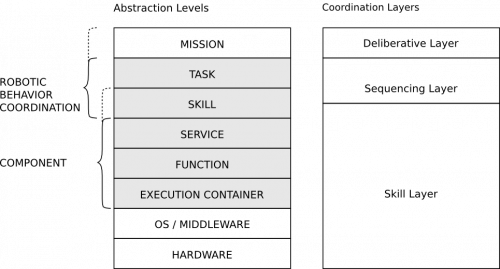Note: This is a snapshot of the RobMoSys Wiki as of June 23rd 2017.
Live Version for this page.
general_principles:architectural_patterns:robotic_behavior
Table of Contents
Architectural Pattern for Task-Plot Coordination (Robotic Behaviors)
A description of this architectural pattern can be found here. The architecture is a generic architecture for robotics behavior. Its implementation in the SmartSoft World is SmartTCL and Dynamic State Charts. In terms of the abstraction levels, this pattern addresses task and skill levels; in terms of concerns, it addresses coordination and configuration.
To be extended. This architectural pattern is about:
- continuous vs. discrete
- task-plot description (i.e. hierarchical task-tree)
- using external solvers as experts on demand (i.e. symbolic planer)
Context
…
Problem
…
Solution
Discussion
…
Acknowledgement
This document contains material from:
- Lotz2017 Alex Lotz, “Managing Non-Functional Communication Aspects in the Entire Life-Cycle of a Component-Based Robotic Software System,” 2017. (unpublished work)
- Lutz2017 Matthias Lutz, “Model-Driven Behavior Development for Service Robotic Systems: Bridging the Gap between Software- and Behavior-Models,” 2017. (unpublished work)
- Stampfer2017 Dennis Stampfer, “Contributions to Composability using a System Design Process driven by Service Definitions for Service Robotics,” 2017. (unpublished work)
general_principles:architectural_patterns:robotic_behavior · Last modified: 2019/05/20 10:49
http://www.robmosys.eu/wiki-sn-01/general_principles:architectural_patterns:robotic_behavior
http://www.robmosys.eu/wiki-sn-01/general_principles:architectural_patterns:robotic_behavior


